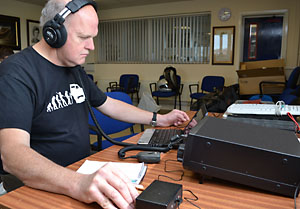HF DXing – how to do it
Listening is one of the important skills any DXer needs to learn. The most experienced operators on the bands spend far more time listening than actually transmitting.
Many rare stations get spotted on the DX Cluster, but as soon as they do a whole host of amateurs will descend upon them and you won’t get a look in.
Sometimes it is better to find the DX for yourself. A little experience on the bands will help you develop a sense of what to listen for: a different accent may indicate someone from a different area of the world from all the other signals that can be heard, a ‘fluttery’ signal may indicate that it is coming from across the north pole, or a station talking about his QSL manager may indicate that he is in a rare location.
These and many other tell-tale signs become almost second nature indicators to the experienced DXer. However, one of the biggest give-aways is a pile-up.
At certain times an enormous cacophony of noise may be heard on the band. Underneath or to one side of this there may be a rare or interesting station.
A pile-up is a certain indication that a station of interest is around. Competition may be stiff, but against this, the contacts are usually swift, allowing more people to have a chance. Also by developing the skills it is possible to become very successful in making contact under these conditions.
Many DXpeditions operate split frequency – that is, they transmit on one frequency and listen on another. This can be confusing at first, but it is worth listening to find out that is going on. Often the DX station will say “listening up” or “listening up five”, This means, for example, that they are transmitting on 14.210MHz and listening on 14.215MHz.
If they don’t specify a listening frequency and just say “listening up”, this probably means that they are moving their VFO around between, perhaps, 5-20KHz up from where they are – you have to find out exactly where. They might say “up five to ten”, meaning they are listening somewhere between five to 10kHz higher.
To do this you need to find the other amateur they are actually working using your second VFO and by setting your two VFOs on different frequencies. Listen for the other station give them a signal report and you can jump in after their QSO has finished, making sure you have engaged the “Split” function on your radio.
One thing, if the DX station is saying “North America only”, just stop – and listen. If you continue to call you will just cause QRM (interference) and the DX station won’t work you anyway as you are in the UK.
Some DX stations will work “by numbers”. That is, they will ask for “any stations with zero”, meaning any stations with zero in their prefix. If you have the call M6ABC then you must wait until they ask for “stations with six in the call”.
If you are in any doubt don’t transmit – just remember that potentially hundreds of hams will be listening to any mistake you make. And they will let you know!
If and when it is time to call the DX station just say your callsign – nothing else.
So the DX station says: “This is T32C calling CQ – UK Only”.
You say: “M6ABC”
He says (if you are lucky): M6ABC, you’re five nine”
You say: “You’re also five nine. Thank you”.
There, that’s it. No mention of names, location, the weather or what radio you are using. DX contacts are short and sweet to allow plenty of people to make their contact.
You may hate to hear this, but a lot of DXing is done with Morse code. It can get through when you can barely hear an SSB signal. Whether you decide to learn Morse is up to you, but the results can be worth it.
DXing is addictive, but you are up against the very best, running the highest powers to the biggest beams. It can be a scrum.
The two biggest mistakes are:
- Calling when the DX station doesn’t want to work you – either because he is working by numbers or has said he only wants calls from a specific region.
- Not operating split, when he talks on one frequency but listens on another.
You may not make that DX contact at your first attempt, but when you do get through the feeling you get will make it all worthwhile!
Other pages in this section – Operating your new station:











